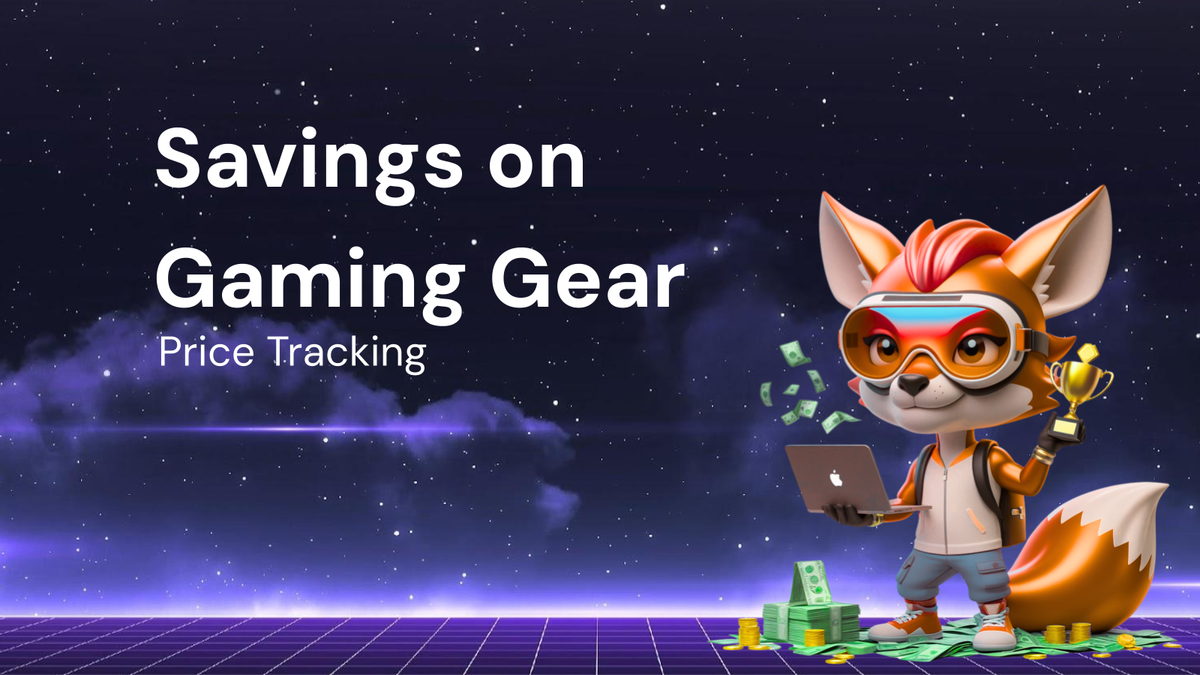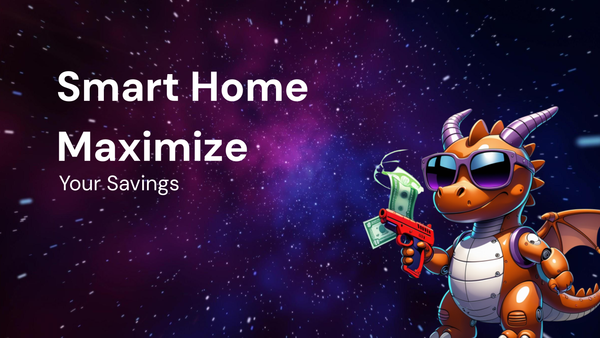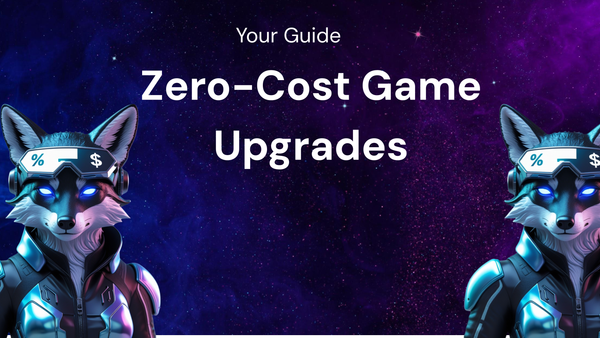Maximize Savings on Gaming Gear with Price Tracking

Level Up Your Savings: Mastering the Art of Price Tracking for Gaming Gear
For gamers, the pursuit of the perfect setup is a never-ending quest. From the latest graphics cards and lightning-fast processors to immersive headsets and ergonomic peripherals, the desire for cutting-edge technology often clashes with the reality of a finite budget. But fear not, fellow adventurers! There's a powerful tool in your arsenal that can help you conquer those daunting price tags: price tracking.
Price tracking isn't just about finding the cheapest deals; it's about becoming a savvy consumer, understanding market dynamics, and strategically planning your purchases. By monitoring price fluctuations and identifying optimal buying opportunities, you can significantly reduce the cost of your dream gaming gear, leaving more room in your wallet for games, subscriptions, and, of course, snacks.
This comprehensive guide will equip you with the knowledge and techniques to become a price-tracking pro, transforming you from a casual shopper to a shrewd bargain hunter. We'll explore the benefits of price tracking, delve into the best tools and strategies, and provide practical tips to maximize your savings on gaming gear.
Why Price Tracking is Essential for Gamers
Before diving into the specifics, let's understand why price tracking is such a vital skill for gamers:
- Volatile Pricing: The gaming gear market is notorious for its fluctuating prices. Demand, supply, new product releases, and even seasonal sales events can all impact the cost of components, peripherals, and accessories. Ignoring these fluctuations means potentially overpaying significantly.
- Identifying Real Deals: Retailers often employ deceptive marketing tactics, creating the illusion of discounts that aren't as substantial as they seem. Price tracking provides a historical perspective, allowing you to discern genuine price drops from inflated original prices.
- Avoiding Impulse Purchases: The allure of a shiny new graphics card can be overwhelming. Price tracking introduces a layer of objectivity, forcing you to analyze the price history and determine if the current offer is truly the best available.
- Budget Optimization: Knowing when and where to buy specific components allows you to allocate your budget effectively. You can prioritize essential upgrades and strategically plan purchases of less critical items based on price trends.
- Discovering Hidden Gems: Price tracking can unveil hidden deals and promotions that might not be readily advertised. It helps you explore different retailers and compare prices across multiple platforms, leading to unexpected savings.
- Taking Control of Your Spending: Ultimately, price tracking empowers you to take control of your spending. It transforms you from a passive consumer to an informed decision-maker, ensuring you get the best possible value for your money.
The Arsenal of Price Tracking Tools
Now that you understand the "why," let's explore the "how." A variety of tools are available to help you track prices and receive alerts when your desired gaming gear goes on sale. Here's a breakdown of some of the most popular and effective options:
- Price Comparison Websites: These websites aggregate prices from multiple retailers, allowing you to quickly compare costs and identify the lowest prices for specific products. Some popular options include:
- PCPartPicker: This is a must-have for building PCs. It not only tracks prices across numerous retailers but also ensures compatibility between components and helps you manage your build's power consumption.
- CamelCamelCamel: Primarily focused on Amazon, this website provides detailed price histories and allows you to set up email alerts for price drops.
- Google Shopping: Google's integrated shopping platform allows you to compare prices across a vast network of retailers.
- PriceRunner: Another comprehensive price comparison website with a wide range of products and retailers.
- Browser Extensions: These extensions integrate directly into your web browser and automatically track prices on the websites you visit. They often display price history graphs and allow you to set up price alerts. Some popular options include:
- Honey: Automatically searches for and applies coupon codes while you shop online, and also offers price tracking features.
- Rakuten (formerly Ebates): Offers cashback rewards on purchases from participating retailers, along with price tracking and coupon finding functionalities.
- Keepa: Specifically designed for Amazon, Keepa provides detailed price history graphs, price alerts, and other useful features.
- Dedicated Price Tracking Apps: Some mobile apps are dedicated to price tracking, offering features such as barcode scanning, price history graphs, and push notifications for price drops.
- BuyVia: Tracks prices across a wide range of retailers and offers push notifications for price drops and local deals.
- ShopSavvy: Allows you to scan barcodes to quickly compare prices from different retailers.
- Retailer-Specific Apps and Websites: Many major retailers, such as Amazon, Best Buy, and Newegg, offer their own price tracking features through their apps or websites. Take advantage of these tools to monitor prices on the products you're interested in.
- Manual Monitoring (Spreadsheets): While less efficient than automated tools, manual monitoring using spreadsheets can be useful for tracking prices on a small number of specific items. Create a spreadsheet with columns for retailer, price, date, and notes, and update it regularly.
Strategies for Maximizing Savings
Choosing the right tools is only the first step. To truly master the art of price tracking, you need to implement effective strategies. Here are some key techniques to maximize your savings on gaming gear:
- Set Realistic Price Alerts: Don't set your price alerts too low. If you're constantly waiting for unrealistic discounts, you might miss out on good deals that are within your budget. Consider setting tiered alerts – one for a significant discount and another for a reasonable price that you'd be happy to pay.
- Understand Price History Graphs: Pay attention to the price history graphs provided by price tracking tools. Look for patterns, such as seasonal price drops or consistent price fluctuations. This information can help you predict future price movements and plan your purchases accordingly.
- Factor in Shipping Costs and Taxes: Don't focus solely on the base price. Remember to factor in shipping costs and taxes to determine the total cost of the item. Sometimes, a slightly higher price with free shipping can be a better deal than a lower price with expensive shipping.
- Be Patient and Persistent: Finding the best deals often requires patience and persistence. Don't be discouraged if you don't see the price you're looking for right away. Keep tracking prices, and eventually, you'll find the perfect opportunity to strike.
- Consider Refurbished or Used Options: If you're on a tight budget, consider purchasing refurbished or used gaming gear. Many retailers offer certified refurbished products with warranties, providing significant savings compared to buying new. Websites like eBay and Craigslist can also be good sources for used gaming gear, but be sure to do your research and inspect the item carefully before buying.
- Take Advantage of Sales Events: Major sales events, such as Black Friday, Cyber Monday, and Amazon Prime Day, often offer significant discounts on gaming gear. Plan your purchases around these events to maximize your savings. However, be aware that retailers sometimes inflate prices before these events to make the discounts appear more significant. Price tracking can help you identify these deceptive tactics.
- Combine Price Tracking with Coupon Codes and Cashback Rewards: Don't rely solely on price tracking. Combine it with other savings strategies, such as using coupon codes and cashback rewards programs. Browser extensions like Honey and Rakuten can automatically find and apply coupon codes, while cashback programs offer a percentage of your purchase back in the form of cash or gift cards.
- Consider Open Box Items: "Open Box" items are products that have been returned to the store, usually in perfect or near-perfect condition. Retailers often sell these items at a discount. Be sure to inspect the item carefully before purchasing to ensure it's in acceptable condition.
- Check for Bundle Deals: Retailers sometimes offer bundle deals, which include multiple products at a discounted price. These deals can be a great way to save money if you need more than one item.
- Set a Budget and Stick to It: It's easy to get carried away when shopping for gaming gear. Before you start tracking prices, set a budget and stick to it. This will help you avoid overspending and ensure you're only buying the items you truly need.
Specific Examples: Optimizing Savings on Common Gaming Gear
Let's illustrate these strategies with examples focusing on specific gaming gear:
- Graphics Cards: Graphics cards are often the most expensive component in a gaming PC. Track prices closely, especially before and after new releases. New cards often cause price drops on older models. Sites like PCPartPicker are essential for tracking GPU prices across multiple retailers. Be aware of availability issues, as high demand can drive prices up. Consider buying a slightly older model if it offers comparable performance at a significantly lower price.
- Gaming Monitors: Monitor prices can fluctuate based on panel type (TN, IPS, VA), refresh rate, resolution, and features like G-Sync or FreeSync. Determine your ideal specifications and track prices on models that meet your needs. Look for deals on open-box or refurbished monitors. Pay attention to response time, input lag, and color accuracy when choosing a monitor.
- Gaming Headsets: Headsets come in a wide range of prices and features. Consider your specific needs, such as wired vs. wireless, surround sound, and microphone quality. Track prices on your desired models and look for deals during sales events. Read reviews carefully to ensure the headset is comfortable and provides good sound quality.
- Gaming Keyboards and Mice: These peripherals are often overlooked but can significantly impact your gaming experience. Consider your preferred switch type (for keyboards) and sensor DPI (for mice). Track prices on your desired models and look for deals during sales events. Consider purchasing a combo deal that includes both a keyboard and a mouse.
- Storage (SSDs and HDDs): Storage prices have become increasingly competitive. Track prices on SSDs (Solid State Drives) and HDDs (Hard Disk Drives) to find the best deals. Consider buying a larger SSD for your operating system and frequently used games, and a larger HDD for storing less frequently accessed files.
Beyond the Purchase: Protecting Your Investment
Price tracking is only part of the equation. Once you've purchased your gaming gear, it's important to protect your investment:
- Consider Warranty Options: Check the warranty offered by the manufacturer or retailer. Extended warranties can provide peace of mind in case of hardware failures.
- Proper Maintenance and Care: Keep your gaming gear clean and well-maintained. Dust your PC regularly to prevent overheating. Use a soft cloth to clean your monitor screen. Store your peripherals in a safe place when not in use.
- Software Updates and Drivers: Keep your operating system, drivers, and software up to date. These updates often include bug fixes and performance improvements that can help extend the lifespan of your gaming gear.
Conclusion: Become a Gaming Gear Price Tracking Master
By mastering the art of price tracking, you can transform yourself from a casual shopper into a savvy bargain hunter. By utilizing the right tools, implementing effective strategies, and remaining patient and persistent, you can significantly reduce the cost of your dream gaming gear, allowing you to enjoy the latest technology without breaking the bank. So, embrace the power of price tracking and level up your savings! Happy gaming!




